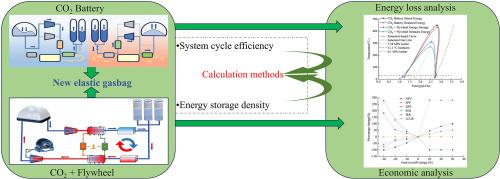Gasbag phase-change carbon dioxide energy storage: Development and economic study
IF 3.6
引用次数: 0
Abstract
The Gasbag Phase-change Carbon Dioxide Energy Storage System leverages elastic gasbags to store carbon dioxide under varying geographical conditions. This approach utilizes the phase-change sensible heat effect to efficiently manage energy storage and release. This technology requires lower pressure and temperature control, resulting in reduced energy consumption and improved efficiency. Additionally, it is less restricted by geographical factors to a certain extent, enabling the formation of a closed-loop system. This contributes to the development of new energy utilization systems. The article examines and compares two experimental energy storage projects employing elastic gasbags to maintain a constant pressure supply of carbon dioxide on the low-pressure side. It further details the precise calculation methods for system cycle efficiency and energy storage density while analyzing energy losses incurred during the storage and release phases. Finally, an economic analysis is conducted using specific data, demonstrating that optimizing temperature and pressure parameters at various nodes enhances overall system efficiency while reducing energy consumption. Furthermore, the study highlights the system's high sensitivity to grid electricity prices. This research is anticipated to contribute to the development of more efficient and reliable energy storage solutions for power systems, addressing the growing energy demands and sustainability challenges.

气囊相变二氧化碳储能:发展与经济研究
气囊相变二氧化碳储能系统利用弹性气囊在不同的地理条件下储存二氧化碳。该方法利用相变显热效应来有效地管理能量的储存和释放。该技术需要更低的压力和温度控制,从而降低了能耗,提高了效率。并且在一定程度上较少受地理因素的限制,形成闭环系统。这有助于发展新的能源利用系统。本文考察和比较了两个采用弹性气囊在低压侧保持二氧化碳恒压供应的实验性储能项目。进一步详细介绍了系统循环效率和储能密度的精确计算方法,同时分析了储能和释放阶段的能量损失。最后,利用具体数据进行经济分析,表明优化各节点温度和压力参数可以提高系统整体效率,同时降低能耗。此外,该研究还强调了该系统对电网电价的高度敏感性。这项研究有望为电力系统开发更高效、更可靠的储能解决方案,解决日益增长的能源需求和可持续性挑战。
本文章由计算机程序翻译,如有差异,请以英文原文为准。
求助全文
约1分钟内获得全文
求助全文

 求助内容:
求助内容: 应助结果提醒方式:
应助结果提醒方式:


